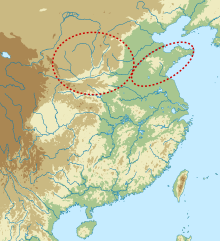Longshan Culture
 |
|||||||||
| Geographical range | China | ||||||||
|---|---|---|---|---|---|---|---|---|---|
| Period | Neolithic China | ||||||||
| Dates | c. 3000 – c. 1900 BC | ||||||||
| Type site | Chengziya | ||||||||
| Major sites | Taosi | ||||||||
| Preceded by | Yangshao culture, Dawenkou culture | ||||||||
| Followed by | Erlitou culture, Yueshi culture | ||||||||
| Chinese name | |||||||||
| Traditional Chinese | |||||||||
| Simplified Chinese | |||||||||
|
|||||||||
| Transcriptions | |
|---|---|
| Standard Mandarin | |
| Hanyu Pinyin | Lóngshān wénhuà |
| Wade–Giles | Lung-shan wen-hua |
The Longshan (or Lung-shan) culture, also sometimes referred to as the Black Pottery Culture, was a late Neolithic culture in the middle and lower Yellow River valley areas of northern China from about 3000 to 1900 BC. The first archaeological find of this culture took place at the Chengziya Archaeological Site in 1928, with the first excavations in 1930 and 1931. The culture is named after the nearby modern town of Longshan (lit. "Dragon Mountain") in Zhangqiu, Shandong. The culture was noted for its highly polished black pottery (or egg-shell pottery). The population expanded dramatically during the 3rd millennium BC, with many settlements having rammed earth walls. It decreased in most areas around 2000 BC until the central area evolved into the Bronze Age Erlitou culture.
A distinctive feature of the Longshan culture was the high level of skill in pottery making, including the use of pottery wheels, producing thin-walled and polished black pottery. This pottery was widespread in North China, and also found in the Yangtze River valley and as far as the southeastern coast.
Until the 1950s, such black pottery was considered the principal diagnostic, and all of these sites were assigned to the Longshan culture. In the first edition of his influential survey The Archaeology of Ancient China, published in 1963, Kwang-chih Chang described the whole area as a "Longshanoid horizon", suggesting a fairly uniform culture attributed to expansion from a core area in the Central Plain. More recent discoveries have uncovered much more regional diversity than previously thought, so that many local cultures included within Chang's Longshanoid horizon are now viewed as distinct cultures, and the term "Longshan culture" is restricted to the middle and lower Yellow River valley. For example, the contemporaneous culture of the lower Yangtze area is now described as the Liangzhu culture. At the same time, researchers recognized the diversity within the Yellow River valley by distinguishing regional variants in Henan, Shanxi and Shaanxi from the Shandong or "classic" Longshan. In the fourth edition of his book (1986), Chang moved from a model centered on the Central Plain to a model of distinctive regional cultures whose development was stimulated by interaction between regions, a situation he called the "Chinese interaction sphere". Also in the 1980s, Yan Wenming proposed the term "Longshan era" to encompass cultures of the late Neolithic (3rd millennium BC) across the area, though he assigned the Central Plain a leading role.
...
Wikipedia
